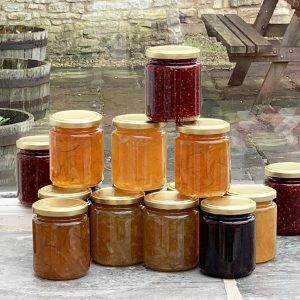For me, April is a month for making Marmalade and Jam from fruit in freezers, to create space for the new season of soft and stone fruit. 
With trees laden with blossom, we hope foran abundant harvest of Plums and Damsons later in the year.
This month has also been about preparing courses for the coming months and teaching 1:1 at home. I was delighted to welcome Amy Neiman, owner of Batch-33 in California to develop her marmalade and jam skills.
Marmalade and Jam Tastings
As with all my teaching, I like to start with tastings of marmalade and jam. Amy brought some of her jars and we evaluated their contents as well as some of mine. We were looking for jams and marmalades with bright, even colours, gelled consistencies and balanced flavours. Each jar has a story about the fruit and the methods used to make it. I use a standard set of principles to evaluate a jar and suggest specific ways to improve it. This is one of the best way to develop the skill of the preserver.
Recipes
As mentioned in other posts, I firmly believe problems with Marmalade and Jam occur largely due to the recipe rather than the skill of the preserver. Amy sourced many of her recipes from the Internet. I tend to advise against using it as a go to source, as many recipes you will find are unbalanced in terms of their ingredients and lack the detailed instructions necessary to make a quality product. We agreed the best Jam and Marmalade are made from pectin rich fruit , although some varieties of citrus fruit make better marmalades than others. Depending on the pectin content, jams are frequently made with at least equal quantities of fruit to sugar and Marmalades with twice the weight of sugar to fruit.
Orange “Jam”
To expand my usual tastings, I made a Seville Orange Marmalade with equal quantities of fruit and sugar, a weight recommendation I’ve seen in American books. The marmalade was made over a few days, cooking the fruit in a similar amount of water to my  standard Seville orange recipe, dissolving the sugar then leaving the ingredients to soak for 24hours. The subsequent boil to a set took longer than I am used to and I ended up with a pan full of peel, insignificant gel, a dense colour and an extremely bitter flavour.
standard Seville orange recipe, dissolving the sugar then leaving the ingredients to soak for 24hours. The subsequent boil to a set took longer than I am used to and I ended up with a pan full of peel, insignificant gel, a dense colour and an extremely bitter flavour.
The photo opposite shows this recipe in the jar on the left and the sample of marmalade on the left side of the plate. The jar on the right and the sample of marmalade on the right hand side of the plate is my standard recipe. When I tested the total sugar content of the marmalade, using a Refractometer it recorded 65% the same reading I get from my standard recipe. Therefore, it appeared using less sugar did not make any difference to the amount of sugar I would be eating on my toast, and the bitter flavour lingered too long in our mouths.
Ingredients
As an Artisan, Amy needed to be aware of the regulations I respect when teaching marmalade and jam. As mentioned in other posts, but always worth repeating, the UK’s Jam and Similar Products Regulations 2003 define Jam as “A mixture, brought to a suitable gelled consistency, of sugars, the pulp or purée or both of one or more kinds of fruit and water”.
Marmalade is “A mixture, brought to a suitable gelled consistency, of water, sugars and fruit pulp….in every case obtained from citrus fruit. Despite the definition, marmalade in particular frequently falls foul of the definition. This year, after reading a post from Rosemary Jameson of the Guild of Jam I became aware of marmalades made by artisans for sale containing cranberries, pumpkin, mango, plums, quince,rhubarb, cider, chocolate, coffee, horseradish and tomatoes.
Practical preserving
Having agreed the best ways to make real jam and marmalade, Amy and I moved on to making two jams and two marmalades. A Four Fruit Marmalade ( lemon, lime, grapefruit and orange) and a Lemon and Vanilla marmalade were prepared to make the following day. I had a batch of cooked damsons ready for the stones to be removed, before the sugar was added and the jam boiled to a set. Removing 150 stones from Damsons was a task better shared than a solo activity.
Looking ahead to our time the following day, I showed Any how I set marmalade with a batch of Seville orange marmalade. I described the different methods of testing for a set and we agreed thermometers were unreliable, the plate test a distraction and the flake test the best.
By day 2 we sailed through the marmalade making and a Raspberry Jam made from frozen fruit. Our time together sped by and I look forward to seeing Amy enjoying great success with her preserves in future.
Links
Guild of Jam and Preserve Makers
Batch 33
First Preserves Books

